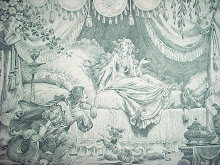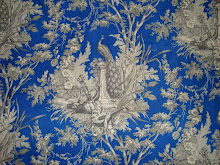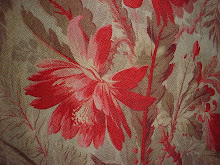








I was very intrigued when I came across 2 of these beautiful toile aprons. They were both made up into pinnies at some point around the late 1800s to early 1900s, I think, but the fabric is quite a bit older, an indigo dyed cotton Toile de Nantes c1815 depicting the story of Jeanne d'Arc, or Joan of Arc. I am trying to imagine the woman that worked away in her kitchen etc proudly sporting such strong patriotic & religious ideas upon her pinny! I shall be wearing mine while preparing Sunday lunch tomorrow...
I did a little research and apparently, quite a few toile manufacturers produced Jeanne d'Arc prints around the same time, probably inspired by a 'politically timed historical novel (by Madame du Genlis in 1816) about The medieval Maid of Orleans. In retelling her triumphs for the French Crown, the author contributed to the revival of her popularity as a national symbol for the Bourbon restoration.' Toiles For All Seasons, Printed French & English Textiles, by Starr Siegele.
I would imagine that the toile was originally used for curtains or beddding, as pictorial toiles where invariably upholstery fabrics. These would have been very costly, and would have been a one-off purchase, usually just after marriage, and would be expected to last a lifetime, and even when damaged or worn, the fabric would never have been thrown away, it was too precious a resource. It would have been folded away safely somewhere until a use could be found for it, or passed on to a poorer relative or favoured servant. Lessons for us to learn here, as usual!
A lovely little piece of cultural history, the stories about their origins usually connect to some kind of contemporary cultural resonance, one of the main reasons I am so besotted with pictorial toiles of the period, especially when seeing the fabrics in the context of domestic use.
I would imagine that the toile was originally used for curtains or beddding, as pictorial toiles where invariably upholstery fabrics. These would have been very costly, and would have been a one-off purchase, usually just after marriage, and would be expected to last a lifetime, and even when damaged or worn, the fabric would never have been thrown away, it was too precious a resource. It would have been folded away safely somewhere until a use could be found for it, or passed on to a poorer relative or favoured servant. Lessons for us to learn here, as usual!
A lovely little piece of cultural history, the stories about their origins usually connect to some kind of contemporary cultural resonance, one of the main reasons I am so besotted with pictorial toiles of the period, especially when seeing the fabrics in the context of domestic use.



































































































Oo-er - mixed feelings about this toile. I was brought up in an English Catholic household with strong feelings about Joan of Arc ( cf Guy Fawkes and no bonfires). And with a later and quite separate love of France, including a second home ( aka 'the ruin') in Normandy.But could the other apron be for sale? I would be very interested if so.
ReplyDeleteHi, I know what you mean, but I think part of what I like so much about such toiles is the appropriation of different historic/mythical etc stories by first one religion, then another, or first 1 nation/political faction, then another accoording to the spin of the time! This apron is currently for sale on ebay, to end next Sunday evening, 22nd November, if you are interested, please follow the link to my shop in the sidebar! All the best, Lois x
ReplyDeleteI love these stories of the toiles. When I saw Joan of Arc, my heart melted....so young, so innocent, so passionate, so idealistic. What a loss. Oh dear, but what a gorgeous toile it makes!
ReplyDeleteYou have such a remarkable treasure trove. yum.
I think this should be framed, it is so lovely.
It is a stunning print! I am keeping the other apron, I love it that such a serious piece of toile has been made up into such a practical item! If I ever find more of this design, I may well have to frame it, it is such an elegant design.
ReplyDelete